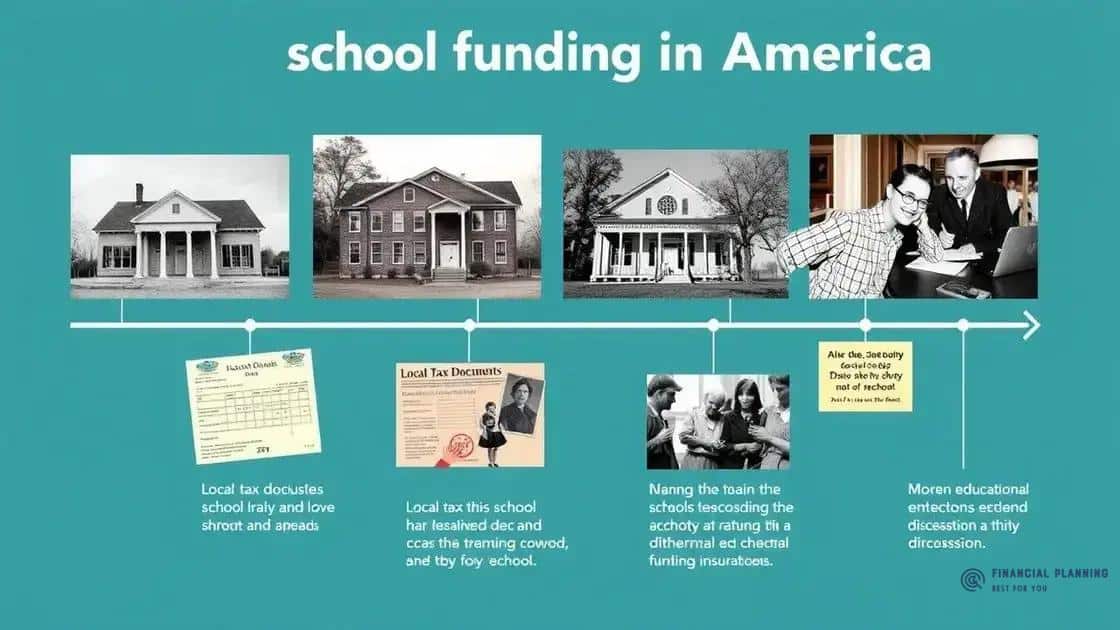Cuts in US federal funding for public schools raise concerns

Cuts in US federal funding for public schools lead to larger class sizes, reduced educational resources, and potential teacher layoffs, significantly impacting the quality of education students receive.
Cuts in US federal funding for public schools have become a concerning topic among educators and parents. As budgets tighten, many wonder what this means for their children’s education. Could it impact their future?
Understanding federal funding for education
Understanding federal funding for education is crucial for grasping the challenges faced by public schools today. Federal funding plays a significant role in providing resources and support to schools across the United States. Many people are unaware of how this funding works and its impact on students and teachers.
What is Federal Funding?
Federal funding refers to the financial support provided by the federal government to state and local educational agencies. This funding aims to enhance educational opportunities and ensure that all students have equitable access to quality education.
Key Sources of Federal Funding
There are various sources of federal funding that support public schools. Here are some key programs:
- Title I Funding: This program aids schools serving low-income students.
- Special Education Funding: Provides support for students with disabilities.
- Perkins Grant: Focuses on improving career and technical education.
These funds help schools meet diverse needs and strive for educational equity. However, as federal budgets tighten, the impacts of cuts can be profound. Schools may face challenges in maintaining essential programs and staff, which can affect overall educational quality.
Moreover, underfunded schools struggle to provide necessary materials for students. Supplies such as textbooks, technology, and classroom resources become scarce. This situation can lead to larger class sizes and reduced support for students, challenging teachers and impacting learning outcomes.
It is essential for communities to be aware of these funding dynamics. Advocacy plays a crucial role in ensuring that federal funding remains a priority for public education. Parents, educators, and community members can unite to voice their concerns and push for adequate funding.
The Future of Federal Education Funding
The future of federal education funding remains uncertain, especially with the increasing demands placed on schools. Continued advocacy is vital for securing the resources necessary for quality education. Understanding how funding works empowers communities, allowing them to take an active role in shaping their educational landscape.
Historical context of school funding

Understanding the historical context of school funding helps us grasp how we arrived at the current challenges in public education. School funding in the United States has evolved significantly over the decades, reflecting changes in policy, societal values, and economic conditions.
Early Funding Models
In the early years of American public education, funding primarily came from local sources, such as property taxes. This system created stark differences in funding between affluent and less wealthy areas. Wealthy neighborhoods could invest heavily in their schools, while others struggled to provide basic resources.
The Shift to State-Level Funding
As awareness of these disparities grew, states began to take on more responsibility for school funding. This led to the establishment of state funding formulas designed to equalize resources. However, these formulas were often complex and varied from state to state, sometimes resulting in continued inequities.
Federal Involvement
The federal government got involved with the introduction of programs like Title I, aimed at assisting underprivileged schools. This was a significant step but did not fully resolve the inconsistencies in funding. The challenge remained as states still relied heavily on local taxes.
Recent Developments
In recent years, there has been a push for more equitable funding policies. Many activists and educators argue that the current system needs a complete overhaul to ensure that all children, regardless of their ZIP code, receive a quality education.
The historical context shows that the journey to equitable education funding is ongoing. Understanding this background is essential for anyone looking to advocate for change and improve the educational landscape for all students.
Implications of funding cuts on educational quality
The implications of funding cuts on educational quality are profound and far-reaching. When public schools face budget reductions, it directly impacts the resources available for students and teachers. These cuts often lead to larger class sizes, fewer educational materials, and limited extracurricular activities.
Impact on Teachers and Staff
Schools that experience funding cuts may have to lay off teachers and support staff. This can create an environment where remaining staff members are overwhelmed with larger class sizes. Consequently, teachers might struggle to provide individual attention to students, which is essential for effective learning.
Reduced Educational Resources
Funding cuts lead to significant reductions in educational resources. Many schools may find it challenging to provide:
- Textbooks and supplies: Essential materials may not be available, hindering students’ learning.
- Technology: Access to computers and other tech tools becomes limited, isolating students from modern learning experiences.
- Support programs: Programs for special education and gifted students often face severe budget constraints.
The decrease in available resources can negatively affect student engagement and achievement. Without proper materials and support, students may feel unmotivated and disengaged from their studies.
Additionally, funding cuts can stifle innovation in teaching methods. Educators may want to introduce new programs or teaching strategies but lack the resources to do so. This stagnation affects not only students’ learning experiences but also their future success and preparedness for higher education or careers.
Long-term Consequences
Ultimately, the implications of funding cuts can lead to diminished educational quality across the board. Students who do not receive a strong educational foundation may struggle in higher education or in the workforce. This cycle can perpetuate socioeconomic disparities and limit opportunities for future generations.
How states are reacting to federal cuts

States are responding to federal cuts in a variety of ways, trying to protect their educational systems while facing budget constraints. The reduction in federal funding has caused concern among state officials, educators, and families alike. Each state’s response varies based on its financial situation, political landscape, and commitment to education.
Increasing State Funding
Some states have stepped up their funding to compensate for the losses. This often involves reallocating state resources to ensure that schools can continue to function effectively. For example, states may increase funding for:
- Supplemental educational programs: These programs can help fill gaps left by federal funding cuts.
- Teacher salaries: Retaining quality educators becomes a priority when federal funds dwindle.
- School facilities: Upgrading buildings and resources is essential for providing a conducive learning environment.
By increasing state funding, education leaders hope to minimize the negative impacts that funding cuts could have on student learning.
Advocating for Policy Changes
In addition to increasing funding, many states are advocating for policy changes at the federal level. State leaders are voicing their concerns and pushing for reforms that prioritize educational funding. This advocacy can take many forms, including:
- Lobbying: State representatives often meet with federal lawmakers to discuss the importance of educational funding.
- Public campaigns: States may launch campaigns to raise awareness about the impacts of cuts and gain support from the public.
- Legal action: In some cases, states have explored legal avenues to challenge federal funding policies.
These actions demonstrate that many states remain committed to fighting for the best interests of their students despite facing financial challenges.
Shifting Responsibilities to Local Districts
As states react to federal cuts, some have started shifting responsibilities to local education districts. This approach can lead to varying degrees of effectiveness, as local districts may not have the same resources as the state.
Some districts might struggle to absorb additional costs, leading to disparities in educational quality. Ultimately, the response to federal cuts reflects a complex interplay between state and local responsibilities, with long-term implications for students across the country.
Community efforts to support local schools
Community efforts to support local schools have become increasingly vital in the face of funding cuts and resource shortages. Many communities recognize that investing in education is essential for the future of their children and the overall health of the local area. These initiatives vary widely and showcase the power of community action.
Organizing Fundraisers and Donations
One of the most common ways communities support their schools is through fundraisers and donations. Local organizations and businesses often step in to help, contributing time and resources. Some effective fundraising activities include:
- Car washes: Simple events that bring the community together while raising funds.
- School fairs: These events can include games, food stalls, and more, promoting school spirit.
- Business sponsorships: Local businesses can sponsor events or provide scholarships.
These activities not only generate funds but also foster a sense of community pride and ownership in local education.
Building Partnerships with Local Organizations
Many schools form partnerships with local organizations, including non-profits and businesses. These partnerships can bring additional resources and support to schools. For example, organizations might help with:
- After-school programs: Providing tutoring or enrichment activities for students.
- Mentorship: Connecting students with role models from the community.
- Workshops: Offering skills training for students and parents.
These collaborations can enhance educational opportunities and create a supportive network for students and families.
Advocating for School Funding
Community members often engage in advocacy to push for increased funding for local schools. This activism can take many forms, including:
- Attending school board meetings: Parents and community members can voice their concerns and advocate for better funding.
- Writing letters to legislators: Communicating with policymakers to highlight the importance of education.
- Rallying support: Organizing events to raise awareness about the need for educational resources.
Through these efforts, the community can play a critical role in shaping education policies and ensuring that local schools have the funding they need to thrive.
In conclusion, addressing the cuts in US federal funding for public schools is crucial for ensuring that every student receives a quality education.
Communities are stepping up by organizing fundraisers, building partnerships, and advocating for policy changes that promote financial support for schools.
Together, these efforts can help mitigate the effects of cuts and improve the educational landscape for future generations. With collaboration and commitment, we can strive to create a more equitable educational environment for all.
FAQ – Frequently Asked Questions about Cuts in US Federal Funding for Public Schools
What are the main effects of funding cuts on public schools?
Funding cuts can lead to larger class sizes, reduced educational resources, and potential layoffs of teachers and staff, negatively impacting student learning.
How are communities supporting local schools facing funding cuts?
Communities are organizing fundraisers, building partnerships with local organizations, and advocating for policy changes to provide additional support to schools.
What role do state governments play in responding to federal funding cuts?
State governments can increase funding to schools, advocate for better policies, and sometimes shift responsibilities to local districts to ensure educational quality.
Why is community involvement crucial for education?
Community involvement fosters collaboration, enhances educational opportunities, and ensures that schools have the necessary resources to provide quality education for all students.





